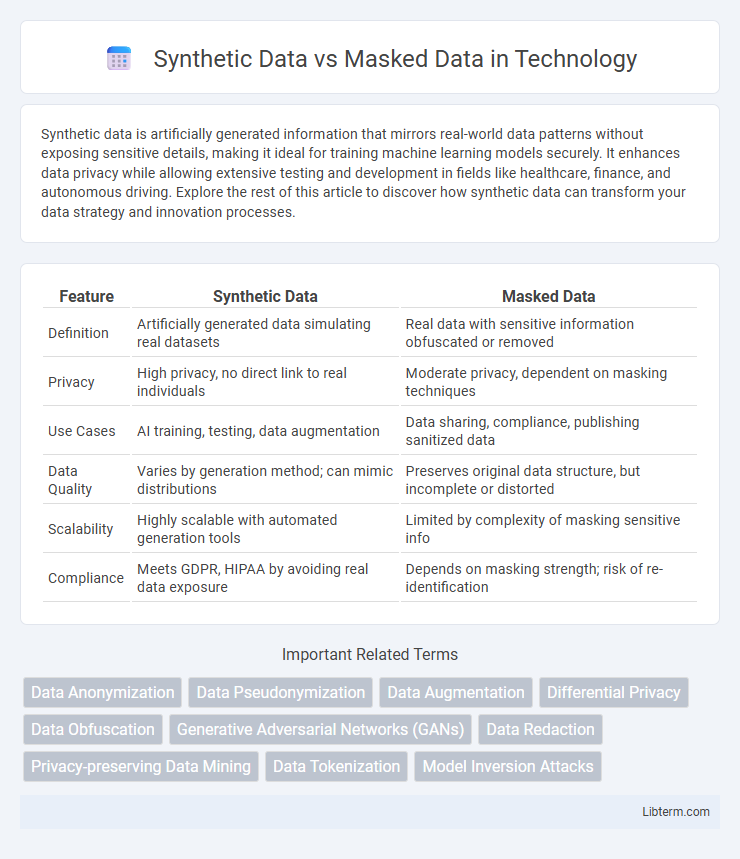Synthetic data is artificially generated information that mirrors real-world data patterns without exposing sensitive details, making it ideal for training machine learning models securely. It enhances data privacy while allowing extensive testing and development in fields like healthcare, finance, and autonomous driving. Explore the rest of this article to discover how synthetic data can transform your data strategy and innovation processes.
Table of Comparison
| Feature | Synthetic Data | Masked Data |
|---|---|---|
| Definition | Artificially generated data simulating real datasets | Real data with sensitive information obfuscated or removed |
| Privacy | High privacy, no direct link to real individuals | Moderate privacy, dependent on masking techniques |
| Use Cases | AI training, testing, data augmentation | Data sharing, compliance, publishing sanitized data |
| Data Quality | Varies by generation method; can mimic distributions | Preserves original data structure, but incomplete or distorted |
| Scalability | Highly scalable with automated generation tools | Limited by complexity of masking sensitive info |
| Compliance | Meets GDPR, HIPAA by avoiding real data exposure | Depends on masking strength; risk of re-identification |
Introduction to Synthetic Data and Masked Data
Synthetic data refers to artificially generated data that mimics real-world datasets while preserving privacy and enabling advanced analytics without exposing sensitive information. Masked data involves the obfuscation or alteration of original data elements to protect confidentiality, often used in data sharing or testing environments to prevent unauthorized access. Both techniques address privacy concerns but differ in generation methods, with synthetic data created from models and masked data derived from existing datasets.
Key Definitions: What is Synthetic Data?
Synthetic data refers to artificially generated information created using algorithms and statistical models that mimic the properties and patterns of real-world data without containing any actual personal or sensitive information. It enables data scientists and organizations to train machine learning models, perform testing, and conduct analysis while preserving privacy and compliance with data protection regulations. This data type is especially valuable in fields like healthcare, finance, and autonomous driving where access to real data is limited or restricted.
Key Definitions: What is Masked Data?
Masked data refers to information that has been deliberately altered to protect sensitive details by replacing original data with obscured or anonymized values, ensuring privacy while maintaining the structure for analysis. It is commonly used in data masking techniques such as tokenization, character substitution, or encryption to prevent unauthorized access to personally identifiable information (PII). Unlike synthetic data, which is artificially generated data resembling real datasets, masked data preserves the original data format but hides actual content.
Importance of Data Privacy in Modern AI
Synthetic data offers a crucial advantage in modern AI by generating artificial datasets that preserve statistical properties without exposing real personal information, thereby enhancing data privacy. Masked data techniques anonymize sensitive details within original datasets, reducing privacy risks while maintaining utility for model training. Emphasizing data privacy is essential to comply with regulations like GDPR and CCPA, ensuring ethical AI development and protecting user trust.
Use Cases: When to Choose Synthetic Data
Synthetic data excels in scenarios requiring privacy-preserving machine learning where real data is scarce or sensitive, such as healthcare and finance. It enables robust model training without compromising personal information, suitable for testing algorithms under diverse conditions. Choose synthetic data when data augmentation and compliance with stringent privacy regulations like GDPR are critical.
Use Cases: When to Choose Masked Data
Masked data is ideal for use cases requiring privacy-preserving data sharing, such as training machine learning models on sensitive healthcare or financial datasets without exposing personally identifiable information (PII). It enables compliance with regulations like GDPR and HIPAA by obscuring confidential attributes while retaining the original data structure for accurate analysis. Masked data is preferred when maintaining data authenticity and relational integrity is crucial for testing or audit purposes.
Benefits and Limitations of Synthetic Data
Synthetic data offers the benefit of enhancing privacy by generating artificial datasets that mimic real data without exposing sensitive information, making it ideal for training machine learning models where data confidentiality is paramount. It provides scalability and flexibility, allowing for diverse scenarios and rare cases to be simulated, which is often challenging with masked data limited to partial alteration of real datasets. However, synthetic data may lack the nuanced authenticity and contextual correlations found in original datasets, potentially leading to reduced model accuracy or bias if the generation algorithms are not sufficiently advanced or representative.
Benefits and Limitations of Masked Data
Masked data enhances privacy by anonymizing sensitive information while maintaining the dataset's original structure, enabling safer data sharing and analysis. However, it may still retain some re-identification risks due to incomplete obfuscation and can reduce data utility by distorting key attributes, limiting accurate model training. Masked data is suited for compliance with data protection regulations but often requires careful validation to balance confidentiality with analytical value.
Comparative Analysis: Synthetic Data vs Masked Data
Synthetic data is artificially generated using algorithms to resemble real datasets without containing any actual personal information, enhancing privacy while maintaining statistical relevance. Masked data involves altering or obfuscating sensitive information within existing datasets through techniques like encryption, tokenization, or hashing, preserving the original data structure but limiting exposure risks. Compared to masked data, synthetic data offers stronger privacy guarantees with reduced re-identification risks, though it may require more complex generation processes to ensure high fidelity and usability in machine learning applications.
Future Trends in Data Privacy and Data Anonymization
Synthetic data generation leverages advanced AI models to create entirely new datasets that preserve statistical properties without exposing real personal information, enhancing future data privacy frameworks. Masked data techniques involve selectively redacting or encrypting sensitive elements within datasets, but face limitations in maintaining data utility as privacy regulations tighten. Future trends indicate a growing adoption of synthetic data for robust anonymization, driven by stricter data protection laws like GDPR and CCPA, alongside innovations in differential privacy and federated learning.
Synthetic Data Infographic

 libterm.com
libterm.com